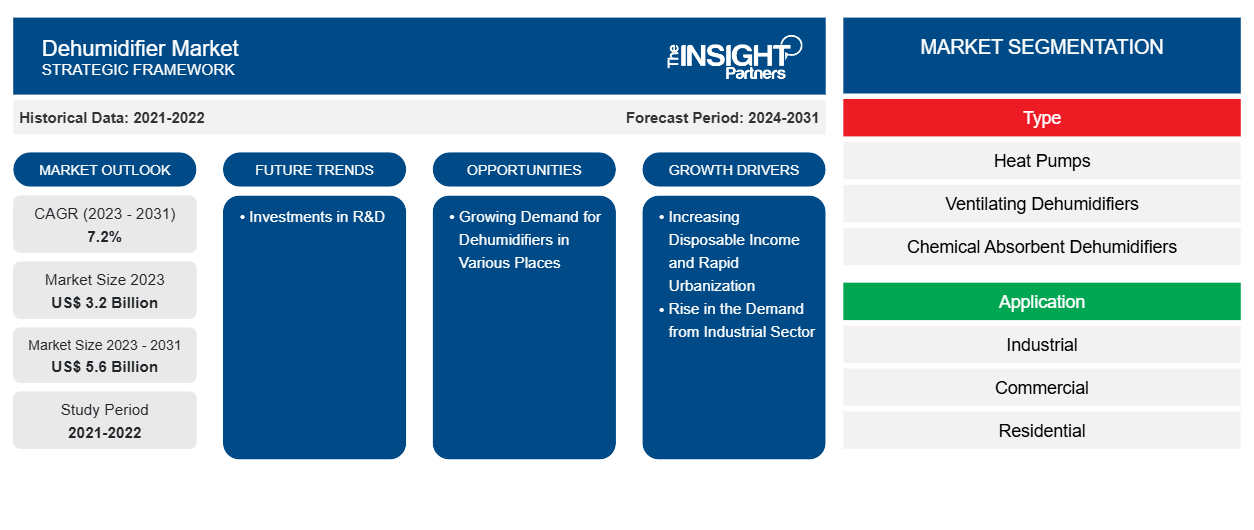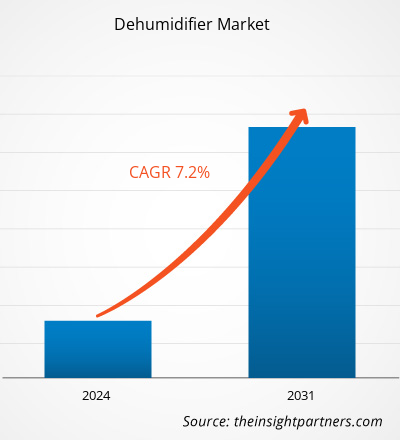The dehumidifier market size is projected to reach US$ 5.6 billion by 2031 from US$ 3.2 billion in 2023. The market is expected to register a CAGR of 7.2% during 2023–2031. Increasing disposable income and rapid urbanization are likely to remain key trends in the market.
Dehumidifier Market Analysis
The enhancement of the world economy, accompanied by urban development, has resulted in a rise in construction across different sectors. This construction boom, which includes malls, hospitals, office buildings, hotels, and industrial plants, has increased the need for dehumidifiers. Progress in technology and the development of energy usage regulations at both government and organizational levels have also contributed to the expansion of the market. There is a increasing inclination towards advanced dehumidifiers that can independently measure and regulate air moisture, as well as the integration of cloud-based technology that enables connectivity with smart devices, both of which have greatly hastened market growth.
Dehumidifier Market Overview
Significantly, regulations imposed by the government, like the energy efficiency testing criteria set by the U.S. Department of Energy, are impacting the market's behavior. Moreover, the market is being positively affected by an improved standard of living and a growing consumer consciousness regarding health-related factors. The rising need for portable dehumidifiers in homes and businesses, coupled with the integration of easy-to-use digital controls in modern dehumidifier units, is driving market expansion, especially in the residential sector. Furthermore, energy efficiency-focused government regulations and standards, such as AHAM 7008-2018/CSA SPE-7008-18/UL 7008-18, are further bolstering the use of dehumidifiers in residential and industrial sectors. These combined factors are instrumental in driving the overall expansion of the market.
Customize This Report To Suit Your Requirement
You will get customization on any report - free of charge - including parts of this report, or country-level analysis, Excel Data pack, as well as avail great offers and discounts for start-ups & universities
Dehumidifier Market: Strategic Insights

-
Get Top Key Market Trends of this report.This FREE sample will include data analysis, ranging from market trends to estimates and forecasts.
Dehumidifier Market Drivers and Opportunities
Increasing Disposable Income and Rapid Urbanization to Favor Market
The global dehumidifier market is experiencing growth due to several key factors. The rising adoption of dehumidifiers in both commercial and residential spaces, along with rapid urbanization and increasing disposable income, are driving this growth. In various developing countries across the Asia Pacific, the demand for dehumidifiers is increasing due to the growing investments in construction activities for residential and commercial spaces. This demand is particularly evident in storage spaces where lithium batteries and other electronic equipment are stored. Additionally, the fluctuating weather conditions caused by factors such as global warming are contributing to the growth of the dehumidifier market. In Europe, the demand for dehumidifiers is expected to rise in the coming years, especially in establishments such as restaurants, hotels, resorts, cafeterias, food and beverage processing centers, and cold storage spaces.
Growing Demand for Dehumidifiers in Various Places
Health clubs need commercial dehumidifiers not only in swimming pools and spa areas but also in moisture-heavy workout spaces. These dehumidifiers are essential for controlling moisture, preventing issues such as Mold and mildew, stopping workout equipment from rusting, and maintaining the overall integrity of the building. In compact, humid spaces like those housing therapy pools, hot tubs, or spas, a commercial dehumidifier is utilized to extract surplus moisture. Furthermore, due to the relatively limited room volume compared to the moisture produced, specialized low-volume CFM commercial dehumidifiers are necessary to restrict the number of room air changes passing through the dehumidifier to a suitable level. All of these benefits provided by dehumidifiers are expected to boost the adoption of this product.
Dehumidifier Market Report Segmentation Analysis
Key segments that contributed to the derivation of the dehumidifier market analysis are type and application.
- Based on type, the market is bifurcated into heat pumps, ventilating dehumidifiers, and chemical absorbent dehumidifiers. The heat pump segment held a significant market share in 2023.
- In terms of application, the market is divided into industrial, commercial, and residential. The industrial segment held a substantial share of the market in 2023.
Dehumidifier Market Share Analysis by Geography
The geographic scope of the dehumidifier market report is mainly divided into five regions: North America, Asia Pacific, Europe, Middle East & Africa, and South & Central America.
North America is expected to hold a significant position in the market. Companies such as Dehumidifier Corporation of America (DCA) are offering a wide range of humidifiers in this region. Commercial swimming pool enclosures and spa facilities in hotels, health clubs, YMCAs, YWCAs, high schools, universities, retirement communities, fitness centers, and other similar establishments can experience improved conditions with the use of DCA dehumidifiers, particularly in combating high moisture accumulation.
Dehumidifier Market Regional Insights
The regional trends and factors influencing the Dehumidifier Market throughout the forecast period have been thoroughly explained by the analysts at The Insight Partners. This section also discusses Dehumidifier Market segments and geography across North America, Europe, Asia Pacific, Middle East and Africa, and South and Central America.
Dehumidifier Market Report Scope
| Report Attribute | Details |
|---|---|
| Market size in 2023 | US$ 3.2 Billion |
| Market Size by 2031 | US$ 5.6 Billion |
| Global CAGR (2023 - 2031) | 7.2% |
| Historical Data | 2021-2022 |
| Forecast period | 2024-2031 |
| Segments Covered |
By Type
|
| Regions and Countries Covered |
North America
|
| Market leaders and key company profiles |
|
Dehumidifier Market Players Density: Understanding Its Impact on Business Dynamics
The Dehumidifier Market is growing rapidly, driven by increasing end-user demand due to factors such as evolving consumer preferences, technological advancements, and greater awareness of the product's benefits. As demand rises, businesses are expanding their offerings, innovating to meet consumer needs, and capitalizing on emerging trends, which further fuels market growth.

- Get the Dehumidifier Market top key players overview
Dehumidifier Market News and Recent Developments
The dehumidifier market is evaluated by gathering qualitative and quantitative data post primary and secondary research, which includes important corporate publications, association data, and databases. A few of the developments in the dehumidifier market are listed below:
- Quest Climate, a pioneer in the humidity control industry, is thrilled to announce a strategic partnership with BFG Supply, a renowned gardening, nursery, and horticultural product distributor, starting in 2024. This collaboration marks an exciting milestone for both companies, aiming to redefine standards in environmental control solutions for the gardening and cultivation industries. Quest has consistently led the market with innovative, high-performance dehumidification technology, catering to the diverse needs of cultivation environments and industrial applications. With a commitment to reliability, energy efficiency, and sustainability, Quest has earned a reputation for excellence and has become the go-to choice for growers worldwide.
(Source: Quest, Company Website, December 2023)
- AprilAire, the nationwide leader in professional-grade Healthy Air solutions for the home, offers inspired innovation and proven energy savings with its line of e-series dehumidifiers. Models E080, E100, and E130 deliver 23% annual energy savings to consumers above conventional products and feature the ENERGY STAR® Most Efficient 2022 rating. These AprilAire dehumidifiers are the first whole-house dehumidifiers to receive this certification from ENERGY STAR and have received the rating for two consecutive years.
(Source: AprilAire, Company Website, April 2022)
Dehumidifier Market Report Coverage and Deliverables
The “Dehumidifier Market Size and Forecast (2021–2031)” report provides a detailed analysis of the market covering below areas:
- Dehumidifier market size and forecast at global, regional, and country levels for all the key market segments covered under the scope
- Dehumidifier market trends as well as market dynamics such as drivers, restraints, and key opportunities
- Detailed PEST/Porter’s Five Forces and SWOT analysis
- Dehumidifier market analysis covering key market trends, global and regional framework, major players, regulations, and recent market developments
- Industry landscape and competition analysis covering market concentration, heat map analysis, prominent players, and recent developments for the dehumidifier market
- Detailed company profiles
- Historical Analysis (2 Years), Base Year, Forecast (7 Years) with CAGR
- PEST and SWOT Analysis
- Market Size Value / Volume - Global, Regional, Country
- Industry and Competitive Landscape
- Excel Dataset
Recent Reports
Testimonials
Reason to Buy
- Informed Decision-Making
- Understanding Market Dynamics
- Competitive Analysis
- Identifying Emerging Markets
- Customer Insights
- Market Forecasts
- Risk Mitigation
- Boosting Operational Efficiency
- Strategic Planning
- Investment Justification
- Tracking Industry Innovations
- Aligning with Regulatory Trends





















 Get Free Sample For
Get Free Sample For